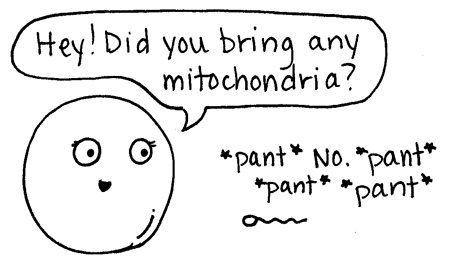Thanks for the Mitochondria, Mom!
By Katie L. Burke
Happy Mother's Day to your mom and your mitochondria!
May 10, 2015
From The Staff Biology
Your parents went halfsies on much of your biological material (for example, your chromosomes), but one of the most important pieces of your cellular machinery came almost exclusively from your mom: mitochondria.These organelles make up the part of the cell that converts food into energy storage molecules (ATP). Although paternal mitochondria do power the sperm’s swim toward an egg, they’re unable to stick around for long. After conception, the egg’s garbage disposals (autophagosomes) get rid of much of the sperm’s machinery, including its mitochondria.

Illustration by Katie McKissick, from her book What’s In Your Genes?
Mitochondria have their own DNA, separate from that of the cells that contain them. The discovery of this DNA bolstered a theory that had long been a subject of speculation among biologists: Mitochondria evolved from bacteria that once lived on their own. Over time, the cells ancestral to your cells and the bacteria ancestral to your mitochondria began to do favors for one another. Eventually, the mitochondrial ancestors began to live in and depend on the other cells.
Mitochondrial DNA turns out to be useful for studying evolution, because it is only passed down through one parent. (In various organisms it may be passed through mom or dad, but in humans it generally comes from mom.) Because mitochondria do not reproduce sexually, as we do, most changes to their DNA happen because of mutation. If we know the average rate of mutation, we can calculate how related different lineages or species are and when their common ancestor lived.
In 1987 mitochondrial DNA provided novel support for the “Out of Africa” hypothesis, which suggested that humans had emerged in Africa and then migrated throughout the world. A group of Berkeley biochemists compared the mitochondrial DNA from people in five diverse geographic regions. They found that among the populations studied, the mitochondrial DNA of people in Africa had about twice as many mutations than that of people from other continents. The finding suggested that the African population’s DNA had had more time to accrue mutational change and was therefore older. Biologists also used the mutation rate of mitochondrial DNA to estimate when the common maternal ancestor to all people alive today—popularly, and perhaps unfortunately, called “Mitochondrial Eve”—once lived.This estimate keeps getting tweaked as we learn more about mitochondrial DNA and the human genome; a 2013 estimate held that this maternal ancestor lived 98,000 to 148,000 years ago. Today, genomics has opened up new ways to study evolution, and the role of mitochondrial DNA in evolutionary biology is changing.
Happy Mother’s Day to our maternal ancestors who gave us our mitochondria!
American Scientist Comments and Discussion
To discuss our articles or comment on them, please share them and tag American Scientist on social media platforms. Here are links to our profiles on Twitter, Facebook, and LinkedIn.
If we re-share your post, we will moderate comments/discussion following our comments policy.